

5 Ways Open Educational Resources Empower Teachers To Choose Their Own Classroom Adventure. By Erika Aparaka “Choose your own adventure!”
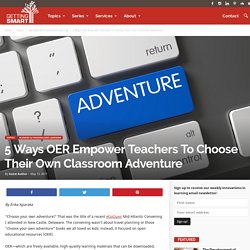
That was the title of a recent #GoOpen Mid-Atlantic Convening I attended in New Castle, Delaware. The convening wasn’t about travel planning or those “choose your own adventure” books we all loved as kids; instead, it focused on open educational resources (OER). OER—which are freely available, high-quality learning materials that can be downloaded, edited and shared—may not seem like they could kick-start an exciting journey, but throughout the convening, teachers shared how these resources have empowered them to chart their own path in better serving their students. One fifth grade teacher, for example, told me how she is looking to provide OER to her students’ parents to help them get more involved in their children’s learning. By the end of the convening, I was convinced that OER truly do enable educators to “choose their own adventures” in their classrooms. 1. 2. 3. 4. 5.
For more, see: How to sort the good from the bad in OER. Editor’s note: This story led off this week’s Future of Learning newsletter, which is delivered free to subscribers’ inboxes every Tuesday with trends and top stories about education innovation.

Teachers often spend many hours at night or on weekends searching the internet for good instructional materials – or just good ideas about how to meld online learning into their classrooms. Sometimes, they consult curation sites that have evaluated these materials; sometimes they just consult other teachers on what they use. The need for reliable evaluation has become more urgent with the flood of new, often free, online materials. These OER – open educational resources – may be good, bad or indifferent. How can school districts or teachers know? “There’s more bad OER out there than good; that’s a fact,” said Rebecca Kockler, assistant superintendent of academic instruction for the state of Louisiana, at the annual SXSWedu conference last week in Austin, Texas. OER reaches ‘inflection point,’ and states are leading the charge.
Special report: Changes in policy, perception and technology are propelling Indiana, Michigan, Utah, Washington and other states to build digital libraries for open educational resources.
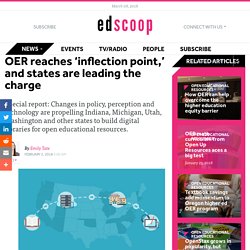
Maria Barreix/EdScoop. New State Legislative Resources. 5 ways to get started with OER. Open Educational Resources haven’t upended the way that K-12 schools get course materials – yet. Free, openly licensed course materials, or open educational resources, have transformed a handful of colleges and many more college courses.
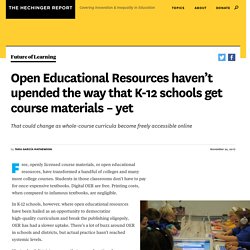
Students in those classrooms don’t have to pay for once-expensive textbooks. Digital OER are free. Printing costs, when compared to infamous textbooks, are negligible. In K-12 schools, however, where open educational resources have been hailed as an opportunity to democratize high-quality curriculum and break the publishing oligopoly, OER has had a slower uptake. There’s a lot of buzz around OER in schools and districts, but actual practice hasn’t reached systemic levels. Open Educational Resources haven’t upended the way that K-12 schools get course materials – yet. The Real Goal of Open Educational Resources. By Stephen DownesNov 15, 2017 Half an Hour 1.
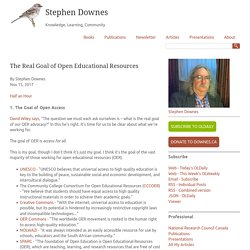
The Goal of Open Access David Wiley says, "The question we must each ask ourselves is – what is the real goal of our OER advocacy? "
FEATURE - What's Up With OER Adoption. FEATURE What’s Up With OER Adoption by Corilee Christou The time has come for K–12 educators to embrace the digital age and, along with it, OERs.

As Erik P.M. Vermeulen states in his Aug. 13, 2017, Hacker Noon post “Education in a Digital Age,” we need “a whole new approach to education … [because] we are experiencing a ‘digitization of reality’. This is the result of the global proliferation of new technologies. We all now live in a ‘digital world’ that is characterized by fast-paced, technology-driven social change.”
Sadly though, not all children — especially those living at the poverty level or below or in rural areas — have access to or live in a digitally empowered environment. #GoOpen. Open Education Resources for teaching. Open Educational Resources (OERs) are, as the name implies, educational resources that are made openly available (usually through an open licence such as one of the Creative Commons licences – for more information please see the creative commons website).
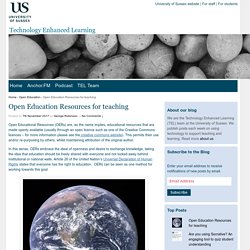
This permits their use and/or re-purposing by others, whilst maintaining attribution of the original author. In this sense, OERs embrace the ideal of openness and desire to exchange knowledge, taking the idea that education should be freely shared with everyone and not locked away behind institutional or national walls. Article 26 of the United Nation’s Universal Declaration of Human Rights states that everyone has the right to education.
OERs can be seen as one method for working towards this goal. “Archive: The Blue Marble” flickr photo by NASA’s Marshall Space Flight Center shared under a Creative Commons (BY-NC) license. States, Not Publishers, Driving Innovation in the Curriculum Marketplace. The Open Access Companion to the Canterbury Tales – A new way to learn about old books. Open pedagogy, Open Educational Practices – You're the Teacher. This post is part of my reflection on an upcoming talk I’m giving at Douglas College about open pedagogy: “What’s Open about Open Pedagogy?”
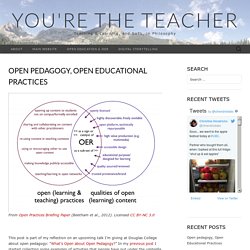
In my previous post I started collecting some examples of activities that people have put under the umbrella of open pedagogy. In an earlier post I collated a number of definitions of open pedagogy, and in my next post I plan to dig more deeply into what I think open pedagogy is and what might be “open” about it. Here I’m going to do a short reflection on possible differences between “open pedagogy” and “open educational practices” (OEP). I have used open pedagogy and OEP interchangeably in the past, and I’m now thinking it might be helpful to consider where they might differ. The following are not in chronological order, but rather an order that makes some logical sense to me as a way to build towards a difference between open pedagogy and OEP. Sharing legally and freely for better learning. The lack of universal access to effective educational resources remains a global problem.
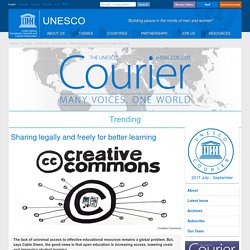
But, says Cable Green, the good news is that open education is increasing access, lowering costs and improving student learning. By Cable Green We live in an age of information abundance where everyone, for the first time in history, can access all the knowledge they wish. The key to this sea-change in education opportunity is Open Educational Resources (link is external)(OER), freely available materials that can be legally downloaded, edited and shared to better serve all students. For the last twenty years, the educational resources – textbooks, videos, courses, degree programmes, etc. – we use to teach people how to read and write, learn physics and think critically have been "born-digital".
But how can educators share digital learning content without violating copyright law – how can they share legally? Leveraging the full power of OER. Education Week. What Difference Does It Make? Last week I shared a little of my thinking about the problems inherent in the way people in the field talk about OER.
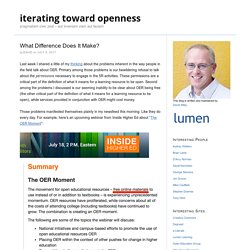
Primary among those problems is our bewildering refusal to talk about the permissions necessary to engage in the 5R activities. Permissions Guide For Educators. School Librarians Advancing STEM Learning. The goal is to support professional learning cohorts to elevate and expand the role of school librarians, and transform their capacities as instructional leaders, who support advancements in STEM learning. Participants will collaboratively create and review curriculum using ISKME’s OER Commons library of freely available resources. The resources developed will support student critical thinking, analysis, and problem solving across STEM disciplines as well as close reading of texts and math integration, in alignment with the Common Core State Standards (CCSS) and state and national science standards. The project is led by ISKME, in partnership with the New Hampshire Department of Education, Granite State College, and New Hampshire's Institutions of Higher Education (IHE) Network.
The project is supported by the Institute of Museum and Library Services. What is OER? Q&A with TJ Bliss: It's an exciting time for open educational resources. About a month ago, Hewlett Foundation’s open educational resources grantees gathered in Canada to reflect on progress in the OER field and how equity plays a role.
Coming out of the conference, we asked education program officer TJ Bliss what trends he’s keeping an eye on in the OER space. A few of my favorite things (#NEOERsummit17) OER Rubric.pdf. Welcome to Open Educational Resources - ACRL/EBSS Open Education Resources for Teacher Education - LibGuides at ACRL. The teacher's guide to Creative Commons licenses. The Creative Commons licenses are crucial tools for making and using Open Educational Resources (OER). They provide authors and makers with the legal means to allow their work to be redistributed and even modified. So what can you actually do with them?
How do you use them correctly and what do the different licenses mean? In this blog, we’ll give you an overview of the six license types and what each one lets you do. Achieve OER Rubrics. To help states, districts, teachers, and other users determine the degree of alignment of Open Educational Resources (OER) to college- and career-ready standards and to determine other aspects of quality of OER, Achieve has developed eight rubrics in collaboration with leaders from the OER community. Achieve partnered with OER Commons to develop an online evaluation tool to allow users to apply these rubrics and evaluate the quality of instructional resources. OER Commons, an online repository for open education resources, is now hosting the tool and its resulting evaluation data.
Every resource available on OER Commons contains an "Evaluate Resource" button that will direct users to the evaluation tool. The coding for the tool is freely available online here. Resources rated on OER Commons will create a pool of metadata, and this metadata will be shared through the Learning Registry with other interested repositories. Free Is Good. Open educational resources (OER) are found in the public domain and can be used for free for teaching, learning, research, and other educational purposes. These materials can be retained, reused, revised, remixed, and redistributed. These “5R permissions” of OER allow you to not only access the materials and resources free of charge, but also to make them even better.
Sounds good, right? 5 Ways Open Educational Resources Empower Teachers To Choose Their Own Classroom Adventure. Open Educational Resources: Equity & Opportunities. The NAACP’s embracing of open education resources (OER), as detailed in the 2016 Advocacy to Promote Use of Open Education Resources Resolution, suggests a way forward that brings together the resources and knowledge of state education agencies and the grassroots influence of civil rights advocates. Together, they can create the conditions that can advance the use of OER in schools across the state—which, in turn, can help create better educational opportunities for every student. Among the strategies these coalitions may consider: Personalizing the Learning Experience: Leveraging Openly Licensed Educational Resources. I distinctly remember walking into my first classroom as a new teacher to find an assortment of desks, items to be used in learning centers, and a set of traditional teacher’s guides for the scope and sequence of learning for all content areas.
These resources were brand new because I had been hired as the new seventh section of Kindergarten in the building. I was excited to open the shrink-wrapped, spiral-bound curriculum and start pouring over the content I would get to teach my soon-to-be students. However, as a new classroom teacher, I quickly realized that I needed to use supplemental resources in addition to the district curriculum. I spent hours scouring the internet, reading countless blogs, crowdsourcing ideas on Twitter, and even paying for my own resources after attending conferences and workshops — all so I could help meet the needs of my students and make learning relevant.
What I did not know was that I was not alone. Educational Technology and Mobile Learning: Tons of Open Educational Resources to Use in Your Teaching. Personalizing the Learning Experience: Leveraging Openly Licensed Educational Resources. Schools Shift to Free, Public-Domain Curricula - WSJ. Education Week. Common Standards, digital innovation, and open resources are transforming the field Educators tasked with finding instructional materials for their districts and classrooms face a dizzying array of options these days.
Classroom resources are available in print, digital textbook formats, and online. They can be paid for, subscribed to, or downloaded for free. They're available as comprehensive, yearlong curricula; individual thematic units; and single activities and games. Several forces have collided to bring the market to this confusing, yet ultimately academically promising point: The majority of states are now using the Common Core State Standards, meaning there are more opportunities to share materials across state lines. And advances in digital technology have made it easier to personalize learning materials for individual students' needs.
The trick is choosing well. Nationwide Curriculum Review. 200 Free Textbooks: A Meta Collection. Free textbooks (aka open textbooks) written by knowledgable scholars are a relatively new phenomenon. Open Education - Office of Educational Technology. We believe that educational opportunities should be available to all learners.
LCS Intro to OER - Google Slides. OER Curricula. Creative Commons. What is OER? - Creative Commons. OER » Quality Content - SETDA. Implementation In 2010, David Wiley from Brigham Young University contacted Nebo school district about piloting an OER program. The pilot was conducted by the Utah Open Textbook Project, a partnership involving BYU, Nebo School District, and the Office of Education. OPINION: Three misunderstandings about open resources.
With eight fellow superintendents from eight states Now is the time of year when U.S. public school districts spend a combined $8 billion on instructional materials while trying to ensure that schools receive the maximum value for their money. A Brief History of Open Educational Resources - T.J. Bliss & M. Smith. OER: One Size Does Not Fit All. OER Case Studies.
Curated #OER Resources. Tutorials and How-To's on #OER. Advancing OER through Open Government. Oerstrategy.org #OER16. Communicating "Open" #OER16. So, When During the School Day Should Teachers Create Curriculum? 3 Steps for Educators to Take Advantage of OERs. Open Educational Resources - Motherlode of Links - SUNY JCC Technology-Enhanced Instruction. Open Education Resources. What Is OER? Answers to 5 Questions About Open Educational Resources. The Future of Curriculum: Playlists, Open Ed., and Tough Choices for Teachers - Market Brief. Open Education Movement Scales Up - Education Week.